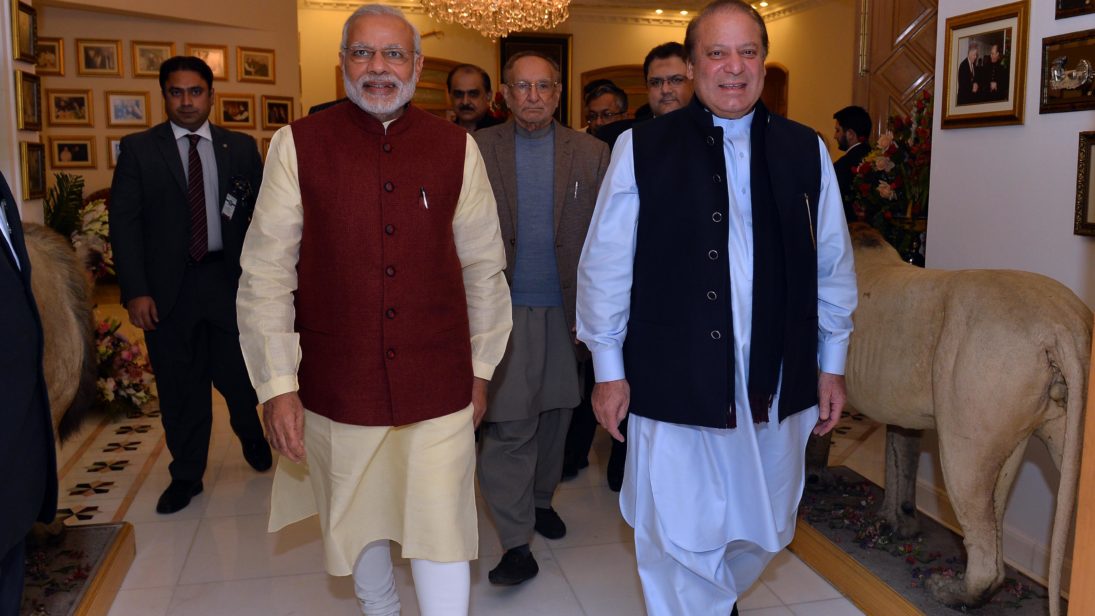
After an initial spurt in 2013, when the PML (N) was voted into power and in 2014 when the BJP assumed control of government, relations between India and Pakistan (which since 2008 have been at a low) have after a short period of optimism once again nosedived. In recent months, border skirmishes have taken place with the Pakistani Defence Minister Khawaja Mohammad Asif reiterating recently that India wants to engage Pakistan in a “low-intensity war.” Broaching the subject of peace, I want to bring forth some pragmatic conjectures to outline how and why peace between India and Pakistan is possible that is informed, paradoxically, with a normative intent that peace between the two countries is desirable. The issue is important because peace, rather than conflict, can bring better dividends to the people of not only Pakistan and India but of the entire South Asian region.
To begin with the present state of affairs, governments in India and Pakistan both have much more in common to kick-start a process of dialogue and reconciliation. Nawaz Sharif has expressed his interest in reviving the peace process with India primarily because of his pro-business approach. The case is similar with Narendra Modi, whose electoral success was predicated largely on the transformation of Gujarat to a now market-oriented citadel of the successful practice of capitalism in India. The key element, then, is how to bring the pro-business, pro-market Modi in consonance with the pro-business, pro-market Nawaz Sharif?
For this to transpire, I argue, a change in perception is needed on both sides. What is the Indian perception of Pakistan? Since 2001 and especially after the Mumbai Attacks of 2008, India has perceived Pakistan and specifically its military establishment as a supporter of terrorism, and that the latter instrumentalises jihadi groups in order to pursue a proxy war against India. The same fears were ignited within India last week when the Indian Defence Minister alleged that a Pakistani boat carrying suspected terrorists was intercepted by the Indian Coast Guard. On the Pakistani side, the conflict with India relates to the fact that it pursues a strategy of isolating Pakistan and in this sense, Pakistan assumes the role of a ‘balancer’ against India’s hegemonic designs in South Asia. Pakistan has staked the claim that India supports insurgents in Balochistan, and interprets the rise of BJP in Indian politics as a sign of anti-Pakistan rhetoric within India.
Perceptions such as the ones mentioned above do not die down easily and are often interpreted as entrenched and essentialist. Perceptions, one might argue, are dependent on actions that are empirically verifiable and hence the Indian and Pakistan perceptions are drawn from observable reality, that is, actual events. However, before one moves down this path of analysis, actions that inform perceptions also have another side to them, what may be termed the counterfactuals. In the case of Pakistan, for example, the same military establishment that is castigated by Indi, has also pursued peaceful diplomacy as time and necessity have dictated. From Ayub Khan’s proposal for a joint defence pact between India and Pakistan to Zia-ul-Haq’s Cricket Diplomacy, to General Musharraf’s Composite Dialogue, the military establishment has shown itself as capable of bowing down to the diktat of peace as much as war. By a similar account, the same BJP which went through with the nuclear tests and is seen as a Hindu nationalist party was also part of the bus diplomacy in 1999 under the premiership of Atal Bihari Vajpayee. While the BJP is credited as nationalist, it is staunchly, if not more, pro-market than the Congress and its policy hinges on pursuing a policy of economic engagement with the West, not one of isolation and autarky, as nationalist parties are wont to do.
What lessons can be drawn keeping the counterfactuals in consideration? First, a Janus-faced characterization of seminal ruling elites in India and Pakistan emerges where conflict and cooperation are enmeshed within the anatomy of a single actor. Taking such a view allows for a more constructivist, contingent perspective that sees hostility not as being deeply rooted and fixed, but rather as contingent and variable. The actors that engage in hostility have on an equal footing the potential and capability to pursue peace. Second, peace will not be served if the ruling elite in India perceive Pakistan as ‘Islamist militants’ or if the Pakistani elite perceive India as the ‘BJP’ or ‘Hindu nationalists.’ Being lands of multiple voices and constituencies, India and Pakistan need to move beyond labelling and framing mindsets that are merely self-serving and undermine the potential for peace. Finally, and most importantly, no matter how hard and intense the war mongering, an all-out war, involving conventional and nuclear weapons, between India and Pakistan is a distant possibility. In fact, it will never take place! It will not be pursued as a rational course of action by leaders of the two states nor will the international community, the United States in particular, allow the two states to go down that road. If this be the case, are not zero-sum national security strategies essentially futile? And are Pakistan and India not better off regulating their conflict and rivalry towards more peaceful outcomes? Security, after all, entails ensuring survival, not annihilation, and the route to survival is by working with, rather than against, each other.
***